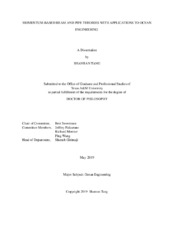| dc.contributor.advisor | Sweetman, Bert | |
| dc.creator | Tang, Shanran | |
| dc.date.accessioned | 2020-04-23T16:18:07Z | |
| dc.date.available | 2021-05-01T12:34:04Z | |
| dc.date.created | 2019-05 | |
| dc.date.issued | 2019-04-05 | |
| dc.date.submitted | May 2019 | |
| dc.identifier.uri | https://hdl.handle.net/1969.1/187918 | |
| dc.description.abstract | Floating offshore wind turbines may be the most practical offshore wind energy technology for deep waters. The dynamics of floating wind turbine systems is highly complicated as they are subject to irregular winds and waves, and platform motions are coupled by gyroscopic effects of the whirling blades. Computing the blade vibration is particularly challenging. The blades are highly flexible and spin around a shaft on a moving tower, introducing large deformations and irregular non-inertial frames. Blade vibration, turbine spin, and platform motion each have distinctively different frequency range, resulting in a multi-scale problem. This study is motivated by solving vibration of blades on a floating offshore wind turbine, in which the underlying theory is the dynamics of arbitrarily-shaped beams having large deformations and overall motions. Developments of two new fundamental dynamic theories are presented; a separation of displacements technique and a linearization method for small angles and small strains are proposed. A geometrically-exact nonlinear beam theory is developed based on conservation of momentum for application to arbitrarily-shaped beams having large deformations and overall motions. Coordinate transformations are used to derive the nonlinear inertial forces and moments and the nonlinear relationships between displacements and strains, enabling rigorous consideration of kinematic and geometric nonlinearities. A geometrically-exact nonlinear theory is subsequently developed for pipes conveying fluid. The derivation follows that of momentum-based beam theory: the dynamic effects of the fluid are included based on the total momentum balance of both the fluid and pipe. The fluid is viscous and is assumed to be incompressible and homogeneous. The resulting pipe theory addresses geometric and kinematic nonlinearities and inertial coupling effects. The separation of displacements technique combined with the linearization method enables nonlinear beam or pipe dynamics to be rigorously reduced to a series of piecewise-linear models. The practical value of these theoretical developments is demonstrated through numerical implementation and examples. The finite volume method is conveniently used for discretization because the underlying theories are based on a conservation law. Two piecewise-linear dynamic solvers, each for beams and pipes, are shown to capture nonlinear dynamics using linear solutions without iteration at each time-step.
Momentum-based beam theory combined with multibody momentum cloud method is applied to model the fully aero-hydro-servo-elastic coupling dynamics of floating wind turbine systems. The momentum-based theory for pipes conveying fluid is demonstrated through practical application to model a top-tensioned marine riser. | en |
| dc.format.mimetype | application/pdf | |
| dc.language.iso | en | |
| dc.subject | Momentum-based theory | en |
| dc.subject | Geometrically-exact beam theory | en |
| dc.subject | Pipe conveying fluid | en |
| dc.subject | Non-inertial reference frames | en |
| dc.subject | Floating offshore wind turbines | en |
| dc.subject | Separation of displacements | en |
| dc.title | Momentum-based Beam and Pipe Theories with Applications to Ocean Engineering | en |
| dc.type | Thesis | en |
| thesis.degree.department | Ocean Engineering | en |
| thesis.degree.discipline | Ocean Engineering | en |
| thesis.degree.grantor | Texas A&M University | en |
| thesis.degree.name | Doctor of Philosophy | en |
| thesis.degree.level | Doctoral | en |
| dc.contributor.committeeMember | Falzarano, Jeffrey | |
| dc.contributor.committeeMember | Mercier, Richard | |
| dc.contributor.committeeMember | Wang, Ping | |
| dc.type.material | text | en |
| dc.date.updated | 2020-04-23T16:18:07Z | |
| local.embargo.terms | 2021-05-01 | |
| local.etdauthor.orcid | 0000-0002-6535-0242 | |


